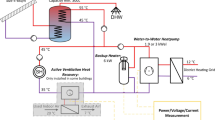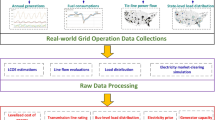Abstract
Growing self-generation and storage are expected to cause significant changes in residential electricity utilization patterns. Commonly applied volumetric network tariffs may induce imbalance between different groups of households and their respective contribution to recovering the operating costs of the grid. Understanding consumer behaviour and appliance usage together with socio-economic factors can help regulatory authorities to adapt network tariffs to new circumstances in a fair way. Here, we assess the effects of 11 network tariff scenarios on household budgets using real load profiles from 765 households. Thus we explore the possibly disruptive impact of applying peak-load-based tariffs on the budgets of households when they have been mainly charged for consumed volumes before. Our analysis estimates the change in household network expenditure for different combinations of energy, peak and fixed charges, and can help to design tariffs that recover the costs needed for the sustainable operation of the grid.
This is a preview of subscription content, access via your institution
Access options
Access Nature and 54 other Nature Portfolio journals
Get Nature+, our best-value online-access subscription
$29.99 / 30 days
cancel any time
Subscribe to this journal
Receive 12 digital issues and online access to articles
$119.00 per year
only $9.92 per issue
Buy this article
- Purchase on Springer Link
- Instant access to full article PDF
Prices may be subject to local taxes which are calculated during checkout



Similar content being viewed by others
References
Pérez-Arriaga, I. J. & Smeers, Y. in Transport Pricing of Electricity Networks Ch. 7 (Springer, Boston, MA, 2003).
Jenkins, J. D. & Pérez-Arriaga, I. J. Improved regulatory approaches for the remuneration of electricity distribution utilities with high penetrations of distributed energy resources. Energy J. 38, 63–91 (2017).
Schreiber, M., Wainstein, M. E., Hochloff, P. & Dargaville, R. Flexible electricity tariffs: power and energy price signals designed for a smarter grid. Energy 93, 2568–2581 (2015).
Linvill, C., Shenot, J. & Lazar, J. Designing Distributed Generation Tariffs Well: Fair Compensation in a Time of Transition (Regulatory Assistance Project, 2013).
Rodríguez Ortega, M. P., Pérez-Arriaga, J. I., Abbad, J. R. & González, J. P. Distribution network tariffs: A closed question? Energy Policy 36, 1712–1725 (2008).
Mountain, B. The rise of distributed generation and storage in South Australia. Energy Spectr. 549, 17–19 (2016).
Bronski, P. et al. The Economics of Grid Defection (Rocky Mountain Institute, 2014); http://go.nature.com/ZXC65t
Nijhuis, M., Gibescu, M. & Cobben, J. F. G. Analysis of reflectivity and predictability of electricity network tariff structures for household consumers. Energy Policy 109, 631–641 (2017).
Schill, W. P., Zerrahn, A. & Kunz, F. Prosumage of solar electricity: pros, cons, and the system perspective. Econ. Energy Environ. Policy 6, 7–31 (2017).
Picciariello, A., Vergara, C., Reneses, J., Frías, P. & Söder, L. Electricity distribution tariffs and distributed generation: quantifying cross-subsidies from consumers to prosumers. Util. Policy 37, 23–33 (2015).
Cossent, R., Gómez, T. & Frías, P. Towards a future with large penetration of distributed generation: Is the current regulation of electricity distribution ready? Regulatory recommendations under a European perspective. Energy Policy 37, 1145–1155 (2009).
Johnson, E., Beppler, R., Blackburn, C., Staver, B., Brown, M. & Matisoff, D. Peak shifting and cross-class subsidization: the impacts of solar PV on changes in electricity costs. Energy Policy 106, 436–444 (2017).
Eid, C., Guillén, J. R., Marín, P. F. & Hakvoort, R. The economic effect of electricity net-metering with solar PV: consequences for network cost recovery, cross subsidies and policy objectives. Energy Policy 75, 244–254 (2014).
Pérez-Arriaga, I. J., Schwene, S., Ruester, S., Batlle, C. & Glachan, J. M. From Distribution Networks to Smart Distribution Systems: Rethinking the Regulation of European Electricity DSOs Final Report (THINK, 2013).
Chapman, A. J., McLellan, B. & Tezuka, T. Residential solar PV policy: an analysis of impacts, successes and failures in the Australian case. Renew. Energy 86, 1265–1279 (2016).
Macintosh, A. & Wilkinson, D. Searching for public benefits in solar subsidies: a case study on the Australian government’s residential photovoltaic rebate program. Energy Policy 39, 3199–3209 (2011).
Castaneda, M., Jimenez, M., Zapata, S., Franco, C. J. & Dyner, I. Myths and facts of the utility death spiral. Energy Policy 110, 105–116 (2017).
Laws, N. D., Epps, B. P., Peterson, S. O., Laser, M. S. & Wanjiru, G. K. On the utility death spiral and the impact of utility rate structures on the adoption of residential solar photovoltaics and energy storage. Appl. Energy 185, 627–641 (2017).
Kind, P. Disruptive Challenges: Financial Implications and Strategic responses to a Changing Retail Electric Business (Edison Electric Institute, 2013).
Severance, C. A. A Practical, affordable (and least business risk) plan to achieve “80% clean electricity” by 2035. Electr. J. 24, 8–26 (2011).
Muaafa, M., Adjali, I., Bean, P., Fuentes, R., Kimbrough, S. O. & Murphy, F. H. Can adoption of rooftop solar panels trigger a utility death spiral? A tale of two US cities. Energy Res. Social. Sci. 34, 154–162 (2017).
Costello, K. W. & Hemphill, R. C. Electric utilities’ ‘death spiral’: hyperbole or reality? Distribution pricing: theoretical principles and practical approaches. Electr. J. 27, 7–26 (2014).
Passey, R., Haghdadi, N., Bruce, A. & MacGill, I. Designing more cost reflective electricity network tariffs with demand charges. Energy Policy 109, 642–649 (2017).
Borenstein, S. The economics of fixed cost recovery by utilities. Electr. J. 29, 5–12 (2016).
McLaren, J., Davidson, C., Miller, J. & Bird, L. Impact of rate design alternatives on residential solar customer bills: increased fixed charges, minimum bills and demand-based rates. Electr. J. 28, 43–58 (2015).
Jargstorf, J., Kessels, K. & Belmans, R. Capacity-based grid fees for residential customers. In 10th International Conference on the European Energy Market (EEM) 1–8 (IEEE, 2013); https://doi.org/10.1109/EEM.2013.6607294
Hledik, R. Rediscovering residential demand charges. Electr. J. 27, 82–96 (2014).
Reneses, J. & Rodríguez Ortega, M. P. Distribution pricing: theoretical principles and practical approaches. IET Gener. Transm. Dis. 8, 1645–1655 (2014).
Simshauser, P. Distribution network prices and solar PV: resolving rate instability and wealth transfers through demand tariffs. Energy Econ. 54, 108–122 (2016).
Strielkowski, W., Štreimikienė, D. & Bilan, Y. Network charging and residential tariffs: a case of household photovoltaics in the United Kingdom. Renew. Sustain. Energy Rev. 77, 461–473 (2017).
Hledik, R. & Greenstein, G. The distributional impacts of residential demand charges. Electr. J. 29, 33–41 (2016).
Rubin, S. Moving toward demand-based residential rates. Electr. J. 28, 63–71 (2015).
Blank, L. & Gegax, D. Residential winners and losers behind the energy versus customer charge debate. Electr. J. 27, 31–39 (2014).
Faruqui, A. The ethics of dynamic pricing. Electr. J. 23, 13–27 (2010).
Bonright, J.C. Principles of Public Utility Rates (Columbia University Press, New York, 1961).
Brown, T., Faruqui, A. & Grausz, L. Efficient tariff structures for distribution network services. Econ. Anal. Policy 48, 139–149 (2015).
Picciariello, A., Reneses, J., Frías, P. & Söder, L. Distributed generation and distribution pricing: Why do we need new tariff design methodologies? Electr. Power Syst. Res. 119, 370–376 (2015).
Sakhrani, V. & Parsons, J. Electricity Network Tariff Architectures: A Comparison of Four OECD Countries No. 10–008 (Center for Energy and Environmental Policy Research, 2010).
Adapting Distribution Network Tariffs to a Decentralised Energy Future (EDSO for Smart Grids, 2015); http://www.edsoforsmartgrids.eu/wp-content/uploads/151014_Adapting-distribution-network-tariffs-to-a-decentralised-energy-future_final.pdf
Network Tariffs (EURELECTRIC, 2016); http://www.eurelectric.org/media/268408/network_tariffs__position_paper_final_as-2016-030-0149-01-e.pdf
Klaassen, E. A. M., Kobus, C. B. A., Frunt, J. & Slootweg, J. G. Responsiveness of residential electricity demand to dynamic tariffs: experiences from a large field test in Netherlands. Appl. Energy 183, 1065–1074 (2016).
Ayres, I., Raseman, S. & Shih, A. Evidence from two large field experiments that peer comparison feedback can reduce residential energy usage. J. Law Econ. Organ. 29, 992–1022 (2013).
Zählwerte, Datenformate und standardisierte Lastprofile, Sonstige Marktregeln Strom—Version 3.3, Kapitel 6, 1–73 (Energie-Control Austria, 2011).
Fares, R. L. & Webber, M. E. The impacts of storing solar energy in the home to reduce reliance on the utility. Nat. Energy 2, 17001 (2017).
Sommerfeld, J., Buys, L., Mengersen, K. & Vine, D. Influence of demographic variables on uptake of domestic solar photovoltaic technology. Renew. Sustain. Energy Rev. 67, 315–323 (2017).
De Groote, O., Pepermans, G. & Verboven, F. Heterogeneity in the adoption of photovoltaic systems in Flanders. Energy Econ. 59, 45–57 (2016).
Zellner, A. An efficient method of estimating seemingly unrelated regressions and tests for aggregation bias. J. Am. Stat. Assoc. 57, 348–368 (1962).
Verordnung der Regulierungskommission der E-Control, mit der die Entgelte für die Systemnutzung bestimmt werden (Systemnutzungsentgelte-Verordnung 2012 in der Fassung der Novelle 2016) SNE-VO 2012 idF Novelle 2016, 1–12 (Energie-Control Austria, 2016); https://www.e-control.at/documents/20903/388512/SNE-2012-idF-Novelle-2016-konsolidiert.pdf/cef56a01-20b8-4b7c-8cb3-9429a6a56271
Acknowledgements
This research was done as a part of PEAKapp project that has received funding under the European Union’s Horizon 2020 research and innovation programme, grant agreement No. 695945 (http://www.peakapp.eu/). A.K. received additional funding from the Austrian Ministry for Transport, Innovation and Technology (No. 848114). D.E. and C.F. gratefully acknowledge the financial support by the Austrian Federal Ministry of Science, Research and Economy, the Austrian National Foundation for Research, Technology and Development and the Federal State of Salzburg. This research was enriched through discussions about international network regulation with B. Mountain, R. Muruais, J. Cohen and D. Pezenka.
Author information
Authors and Affiliations
Contributions
A.K. and J.R. were primarily responsible for the creation and implementation of the survey instrument. D.E. and C.F. were primarily responsible for the creation and management of the dataset, including load profiles. V.A. and J.R. mainly contributed to data analysis. All authors contributed to the writing of the paper with V.A., A.K. and J.R. as the primary authors.
Corresponding author
Ethics declarations
Competing interests
The authors declare no competing interests.
Additional information
Publisher’s note: Springer Nature remains neutral with regard to jurisdictional claims in published maps and institutional affiliations.
Supplementary information
Supplementary Information
Supplementary Figures 1–3, Supplementary Tables 1–6, Supplementary Notes 1–3 and Supplementary References.
Rights and permissions
About this article
Cite this article
Azarova, V., Engel, D., Ferner, C. et al. Exploring the impact of network tariffs on household electricity expenditures using load profiles and socio-economic characteristics. Nat Energy 3, 317–325 (2018). https://doi.org/10.1038/s41560-018-0105-4
Received:
Accepted:
Published:
Issue Date:
DOI: https://doi.org/10.1038/s41560-018-0105-4
This article is cited by
-
Enhancing privacy in smart energy systems
e & i Elektrotechnik und Informationstechnik (2020)
-
Pool detection from smart metering data with convolutional neural networks
Energy Informatics (2019)
-
Impact of advanced electricity tariff structures on the optimal design, operation and profitability of a grid-connected PV system with energy storage
Energy Informatics (2019)
-
Network charges in a low CO2 world
Nature Energy (2018)



